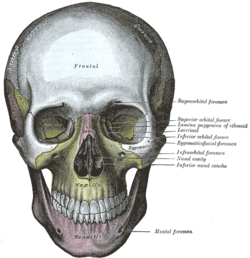Mandibles
| Mandible | |
|---|---|

The mandible
|
|

The human skull, with the mandible shown in purple at the bottom.
|
|
| Details | |
| Precursor | 1st branchial arch |
| Identifiers | |
| Latin | mandibula |
| MeSH | Mandible |
| TA | A02.1.15.001 |
| FMA | 52748 |
|
Anatomical terms of bone
[]
|
|
The mandible,lower jaw or jawbone (from Latin mandibula, "jawbone") is the largest, strongest and lowest bone in the face. It forms the lower jaw and holds the lower teeth in place. The mandible sits beneath the maxilla.
The bone is formed from a fusion of left and right processes, and the point where these sides join, the mandibular symphysis, is still visible as a faint ridge in the midline. Like other symphyses in the body, this is a midline articulation where the bones are joined by fibrocartilage, but this articulation fuses together in early childhood.
The mandible consists of:
The body of the mandible is curved somewhat like a horseshoe and has two surfaces and two borders.
From the outside, the mandible is marked in the midline by a faint ridge, indicating the symphysis or line of junction of the two pieces of which the bone is composed at an early period of life. This ridge divides below and encloses a triangular eminence, the mental protuberance, the base of which is depressed in the center but raised on either side to form the mental tubercle. On either side of the symphysis, just below the incisor teeth, is a depression, the incisive fossa, which gives origin to the mentalis and a small portion of the orbicularis oris. Below the second premolar tooth, on either side, midway between the upper and lower borders of the body, is the mental foramen, for the passage of the mental vessels and nerve. Running backward and upward from each mental tubercle is a faint ridge, the oblique line, which is continuous with the anterior border of the ramus; it affords attachment to the depressor labii Inferioris and depressor anguli oris; the platysma is attached below it.
From the inside, the mandible appears concave. Near the lower part of the symphysis is a pair of laterally placed spines, termed the mental spines, which give origin to the genioglossus. Immediately below these is a second pair of spines, or more frequently a median ridge or impression, for the origin of the geniohyoid. In some cases the mental spines are fused to form a single eminence, in others they are absent and their position is indicated merely by an irregularity of the surface. Above the mental spines a median foramen and furrow are sometimes seen; they mark the line of union of the halves of the bone. Below the mental spines, on either side of the middle line, is an oval depression for the attachment of the anterior belly of the digastric. Extending upward and backward on either side from the lower part of the symphysis is the mylohyoid line, which gives origin to the mylohyoid; the posterior part of this line, near the alveolar margin, gives attachment to a small part of the Constrictor pharyngis superior, and to the pterygomandibular raphé. Above the anterior part of this line is a smooth triangular area against which the sublingual gland rests, and below the hinder part, an oval fossa for the submaxillary gland.
...
Wikipedia
